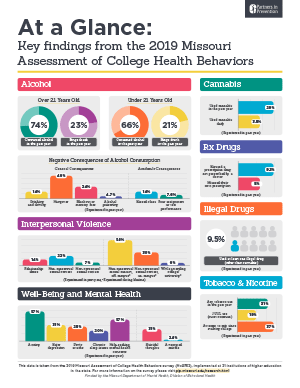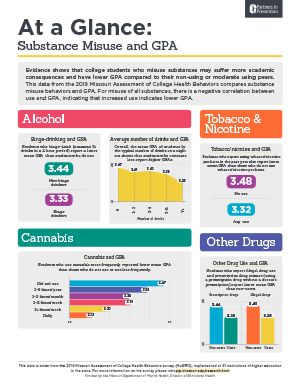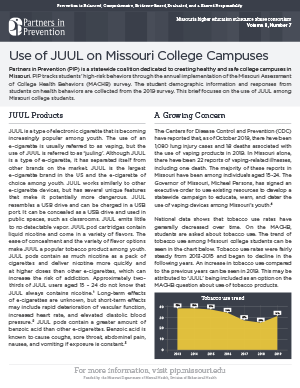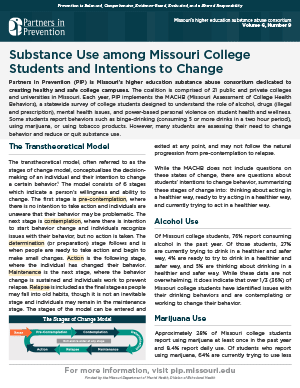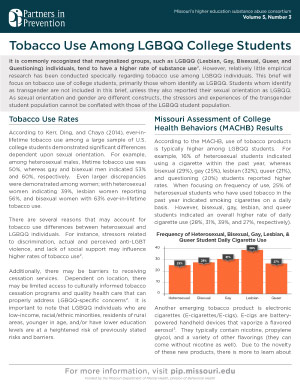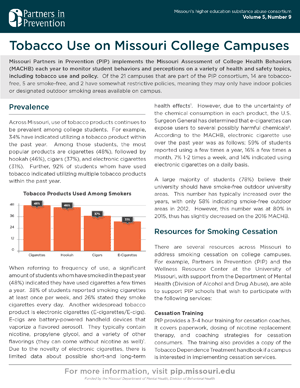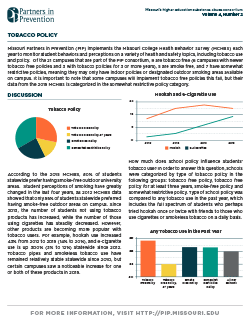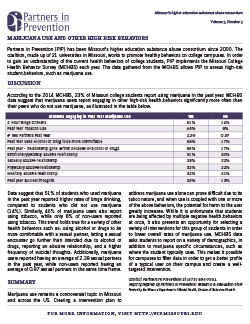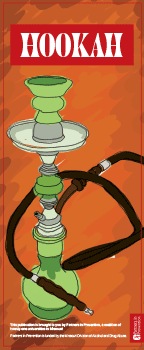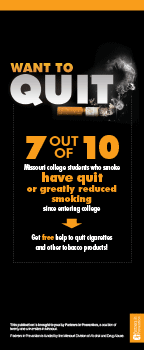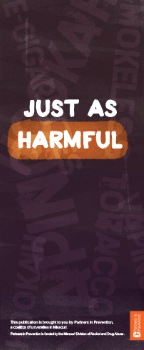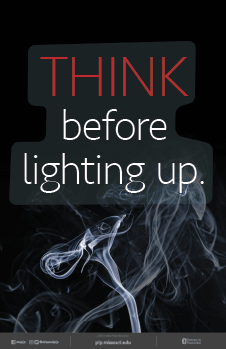
Tobacco

Cigarette smoking is the leading cause of preventable disease and death in the United States, accounting for more than 480,000 deaths every year, or 1 of every 5 deaths.
Nearly 80 percent of all adult smokers begin smoking by age 18; and 90 percent do so before leaving their teens. With the rise of alternate forms of tobacco (e-cigarettes, hookah, etc.) tobacco continues to be a large public health concern. Compiled here are resources to address tobacco use among college students.
Scope
Quick Links
National Data | Missouri Data | Population Considerations | Other Considerations | Electronic CigarettesNational Data
Approximately 13% of college aged students (ages 18-24) smoke cigarettes
In 2015, nearly 7 in 10 adult cigarette smokers wanted to stop smoking.
...and more than 5 in 10 adult cigarette smokers had made a quit attempt in the past year
In high schools nationwide in the past 30 days, 20% reported using a tobacco product in the past 30 days
Missouri Data
75% of Missouri college students have not used a tobacco product in the past year
Missouri college students report rates of use of tobacco products in the past year as follows (check all that apply):
| 19% | 12% | 10% | 8% | 6% | 4% |
| JUUL | Cigarettes | E-Cigarettes | Cigars | Hookah | Smokeless |
| 26% | 24% | 22% | 13% | 6% | 0.4% |
| JUUL | E-Cigarettes | Smokeless | Cigarettes | Cigars | Hookah |
Of students who use tobacco:
- 37% have tried to quit since entering college
- 32% are currently trying to quit or use less often
78% of Missouri college students support having smoke-free outdoor university areas
82% would prefer to go to a bar or restaurant that is smoke-free
Population Considerations
Males are more likely to smoke than females (15% of U.S. adult males vs 13% of females)
Cigarette smoking is highest among American Indians and Alaskan natives and people of multiple races, and lowest among Asian Americans
Individuals living below the poverty line are nearly twice as likely to smoke as those living at or above poverty level (26% vs 14%)
The Midwest has the highest rate of cigarette smoking (almost 19% of the U.S.)
Individuals with disabilities smoke at higher rates than individuals with no disability (21% vs 14%)
Individuals who identify as lesbian, gay, and bisexual were more likely to be smokers than their heterosexual peers (20% vs 15%)
Electronic Cigarettes
Electronic cigarettes
- Electronic cigarettes (known as e-cigarettes, vapes, etc.) are electronic nicotine delivery systems that use battery packs to convert liquid nicotine into a mist or vapor that is inhaled. E-cigarette use is popular among teens and are now the most commonly used for of tobacco among youth in the U.S. (NIDA). E-cigarette use is viewed as less harmful than traditional tobacco products and due to targeted marketing, flavored liquids, and availability, they are very appealing to this age group.
- E-cigarette use may serve as an introductory product for youth and is associated with an increased likelihood in use of other tobacco products.
- The health risks of e-cigarette use include addiction, as nicotine is highly addictive. Use of e-cigarettes also involves heating chemicals and metal before inhaling and the vapor has been shown to contain carcinogens (cancer causing substance) and other toxic chemicals which impact lung health. Use during youth can also impact brain development, attention, learning, mood, and impulse control.
JUULs
- JUULs are one type of electronic cigarette that are becoming increasingly popular among youth. JUULs resemble a USB drive, can be charged in a USB port and emit little to no detectable vapor.
- JUUL pods contain as much nicotine as a pack of cigarettes and deliver nicotine more quickly and at higher doses than other e-cigarettes, which can increase the risk of addiction.
- Approximately two-thirds of JUUL users aged 15 – 24 do not know that JUUL always contains nicotine.
Data Briefs
Click on a brief below for more information.
At a Glance
Volume 8
Volume 6
Volume 5
Volume 4
Volume 3
Volume 1
Best Practices
The CDC has a great guide on best practices for comprehensive tobacco control programs.
Tobacco Free College Campus Initiative has a wealth of resources for campuses to create policies, encourage compliance and enforcement, and more!
The Adolescent Smoking Cessation: Escaping Nicotine and Tobacco Program (ASCENT) program is listed in SAMHSA’s National Registry of Evidence-based Programs and Practices as having effective outcomes for tobacco use.
Stanford Medicine has a great online Tobacco Prevention Toolkit with lots of great information about evidence based tobacco use prevention.
Strategies to Reduce Tobacco Use
- Higher costs for tobacco products (for example, through increased taxes)
- Implement smoke free and tobacco free laws
- Raising the minimum age of sale for tobacco products to 21 years, which has recently emerged as a potential strategy for reducing youth tobacco use
- Community programs and school and college policies and interventions that encourage tobacco-free environments and lifestyles
- Community programs that reduce tobacco advertising, promotions, and availability of tobacco products
- Availability of cessation programs
National Resources
Research
Relevant Research Articles
- Current Cigarette Smoking Among Adults in the United States
- Tobacco Addiction among Youth
- CDC Tobacco Statistics
- CDC Youth and Tobacco Use
- School based programs for preventing smoking
- Tobacco-Control Programs: Evidence-Based Practices
- Smoking and Cessation Behaviors Among College Students
- Motivational Interviewing for Smoking Cessation in College Students: A Group Randomized Controlled Trial
- A Systematic Review of Randomized Controlled Trials: Web-Based Interventions for Smoking Cessation Among Adolescents, College Students, and Adults
